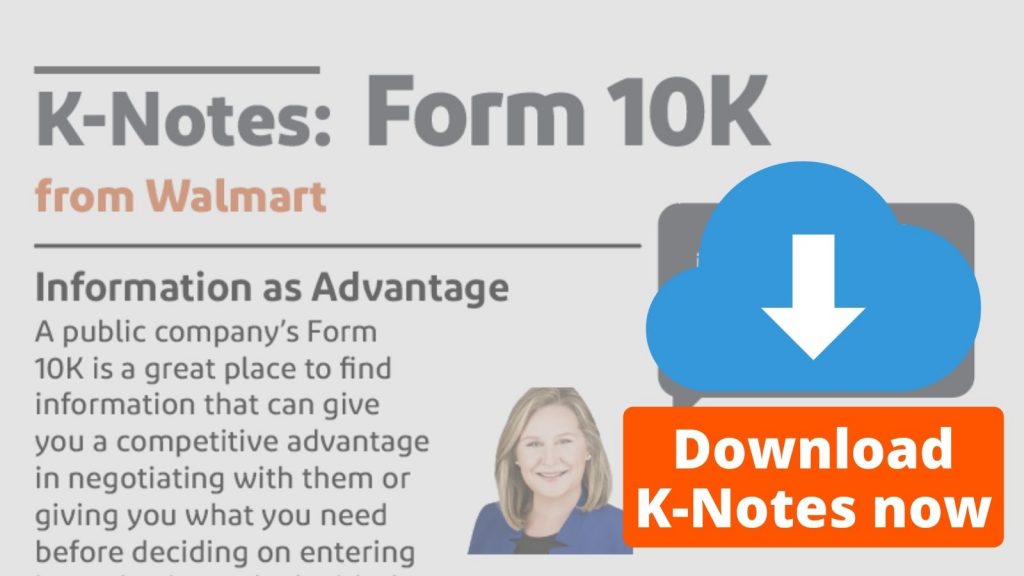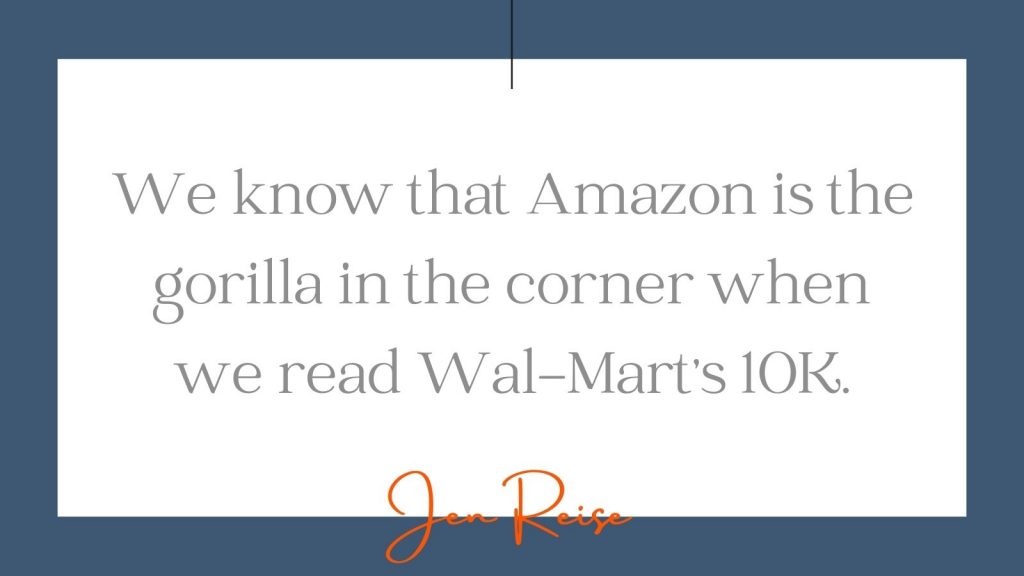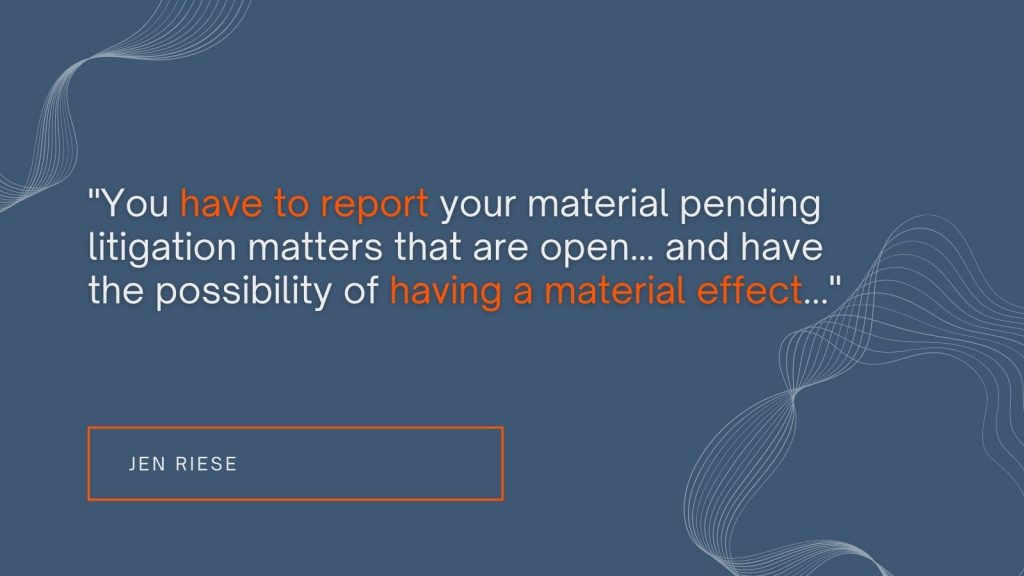If you know where to look, you can find a treasure trove of information in a company’s Form 10-K. In this episode of the Contract Teardown show, Mitchell Hamline School of Law’s Professor Jen Reise talks about Walmart’s 10-K filed for the year 2020 and how you can get a strategic advantage in your deals and litigations with the information in a company’s 10-K.
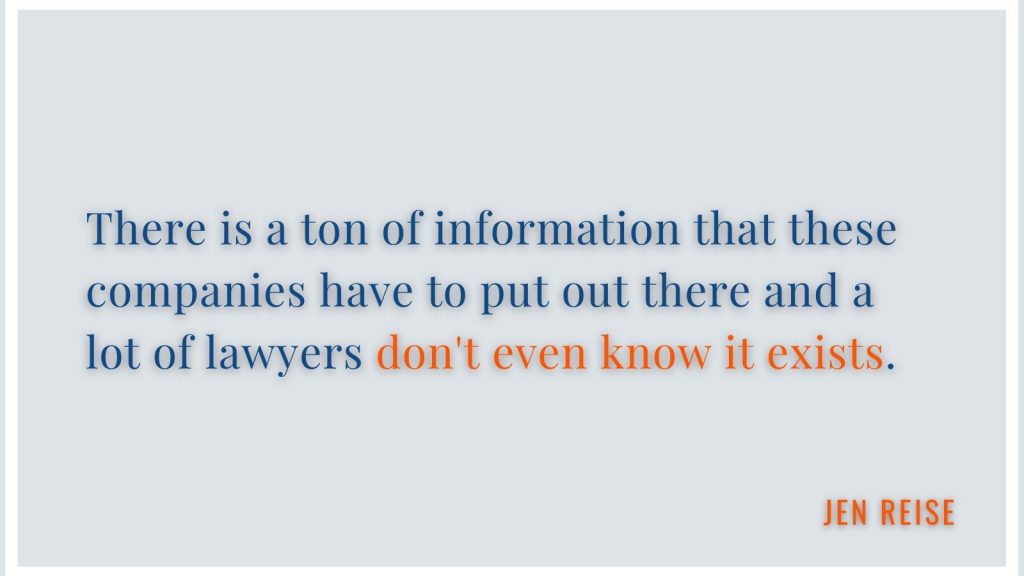
Questions
- What are 10-Ks and 10-Qs?
- Why are they important?
- How can you use the business section as an advantage?
- What can you learn from pending litigation?
- How is stock repurchasing information useful?
What are 10-Ks and 10-Qs?
Attorney Reise explains that the Security & Exchange Commission (SEC) requires public companies to use a periodic reporting system. Most public companies in the US must file a Form 10-K each year with them after closing books on their fiscal year. Companies must update their information during the year by filing quarterly reports on Form 10-Q.
The 10-K is the biggest and longest report public companies file and includes their audited financial report, says attorney Reise. The 10-K is designed to give a detailed picture to the shareholders of the business, along with its operating and financial results and future risks. The 10-Q includes updates about the business and financials and other key measures each quarter.
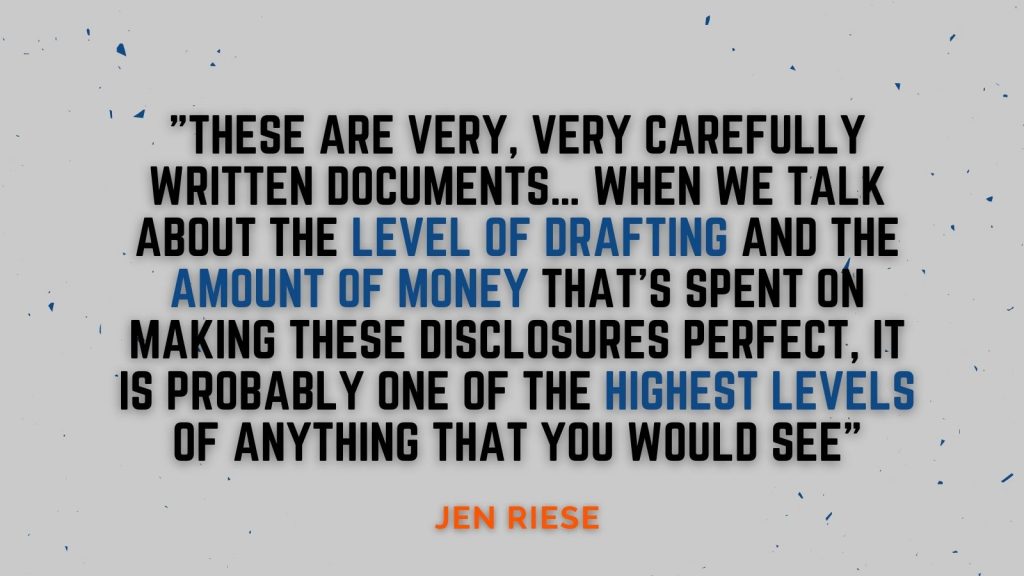
The Business Section
You can use the language found in the business section to know what lingo to use when talking to these companies.
Walmart, like every other reporting company, starts out the 10K with a Business Statement. According to attorney Reise, companies will use this statement as a marketing tool, and it is often aspirational. But, this section has to be highly factual or the company could face the potential of a shareholder lawsuit for overhyping the company’s actual position.
| 1. | Business |
| General | |
| Walmart Inc. (“Walmart,” the “Company” or “we”) helps people around the world save money and live better—anytime and anywhere—by providing the opportunity to shop in retail stores and through eCommerce. Through innovation, we strive to continuously improve a customer-centric experience that seamlessly integrates our eCommerce and retail stores in an omni-channel offering that saves time for our customers. Each week, we serve over 265 million customers who visit approximately 11,500 stores and numerous eCommerce websites under 56 banners in 27 countries. |
Walmart was fortunate they had already started working on in-store pickup and their delivery systems before the pandemic struck, attorney Reise explains. These programs turned out to be hugely successful for Walmart.
One of the items that attorney Reise finds helpful is to look at the type of language the company uses in the business statement. For their new inclusive delivery systems Walmart began using the term Omni Channel.
Attorney Reise views the 10-K as a sort of time capsule: Walmart had this strategy in place before the pandemic to address Amazon. When the pandemic hit, their business exploded. Even though Amazon is not mentioned by name, the competitive background can be read between the lines.
The Company’s Spin On Things
Walmart uses the 10-K to address some of the negative press they received about how they treated their employees. Walmart was roundly criticized for paying wages for a full-time job that could leave you below the poverty line. There were even employee food drives within the store to help the less fortunate employees.
In the 10-K, Walmart tries to put the best light on the situation for the shareholder. They explain how employee relationships and retentions have improved thanks to Walmart’s initiatives.
Property Information
Companies need to describe their properties on the 10-K and Walmart has a lot of them. For properties in the US, Walmart lists 5,355 properties by states, and then subdivides them into the following categories:
- Supercenters
- Discount Stores
- Neighborhood Markets and Small Formats
- Sam’s Clubs
There is also information on how many properties are leased or owned. This can prove valuable information when talking with a company. If you are drafting an agreement that says a party will provide items or services for each store, you’ll need to know how many there are and what they define as a store.
Legal Proceedings
One of the most essential 10-K sections is Legal Proceedings. Walmart needs to disclose pending litigation that will have a material effect on its financial statement. But, with a 2020 revenue of about $520 billion, many minor suits are not material and do not need to be disclosed.
However, one of the listed cases is the National Prescription Opiate Litigation, of which Walmart is one of the named defendants. This case is slowly making its way through the federal court system.
Stock Repurchase
Companies need to disclose to their shareholders how many shares they buy back each quarter, says attorney Reise. In this 10-K, Walmart reports they repurchased $885 million of their own stock.
Use the information in a 10-K as a strategic advantage. #ContractTeardown Click To Tweet
Through its business operations, Walmart threw off a lot of excess cash. According to attorney Reise, stock repurchases give a fascinating insight into business and public policy questions about where Walmart and other companies choose to use its cash. Do they use it to acquire more business, improve their existing business, pay more to their employees, or repurchase some of their stock?
Takeaways
10-Ks have a tremendous amount of company information that most people do not even know exists. They help you get an inside view of the company. This can be a great advantage to you whether you are litigating against the company or entering into a deal with them.
Attorney Reise believes it is primarily a research tool to use when you are engaging with a public company.
With a 10-K, you can gain insight into:
- How the company acts in litigation. Do they vigorously defend? Have they been in litigation with companies similar to yours? What is their litigation strategy?
- What do they consider important? Where is the company spending its cash? What are their future plans?
- What jargon are they using? This will give you an insight into their culture and how to attract their attention for a merger, interview, or even a business transaction.
The 10-K has tons of valuable information that can give you an inside advantage, especially when you look at the legal proceedings section. And since these documents are very carefully drafted, they can serve as good study examples of detailed drafting work.
Show Notes
THE CONTRACT: Walmart’s Form 10K
THE GUEST: Jen Reise is a securities and corporate governance attorney by training. She is in private practice at the Minneapolis office of Taft (formerly Briggs and Morgan), and has worked in-house as SEC and compliance counsel at a public company. She is currently a Visiting Professor at Mitchell Hamline School of Law, teaching business law courses. She is especially interested in negotiation, innovation in the practice and teaching of law, and ensuring that law students graduate with practical and business skills. You can find her on LinkedIn, get in touch by email (jen.Reise@mitchellhamlyn.com) or check out her JD Navigator site, which helps people make informed decisions about law school.
THE HOST: Mike Whelan is the author of Lawyer Forward: Finding Your Place in the Future of Law and host of the Lawyer Forward community. Learn more about his work for attorneys at www.lawyerforward.com.
If you are interested in being a guest on Contract Teardown, please email us at community@lawinsider.com.
Transcript
Mike Whelan [00:00:01] Hey, everybody, I’m Mike Whalen. Welcome back to the Contract Teardown show, I am here with smart friends breaking down documents that you might deal with in your law practice today. I have my friend Jen Reise, how are you today, Jen?
Jen Reise [00:00:16] I’m great, Mike. Thanks for having me on.
Mike Whelan [00:00:18] Happy to have you. We’ve got another cool weird. Every time I invite law professors, we get some weird angle on it. So we’re going to deal with a special kind of document today. Let me screen share real quick with you guys. You can see what we’re talking about. It’s this document called a form 10K. It’s Wal-Mart’s. It’s super long. It’s so many words, so many numbers, 88 pages, I think it was. And I think, Jen, you said that they filed this in March with the SEC, is that right?
Jen Reise [00:00:46] That’s right, Mike. A 10K just gets filed once a year. It’s the big annual report that public companies file. So based on Wal-Mart’s fiscal year, they filed this in March.
Mike Whelan [00:00:54] So tell me, Jen, when are you going to see this kind of document you mentioned? It’s filed once a year. Why does it matter to the lawyers that are zooming in right now and paying attention? Why pay attention to us talking about this weirdo document.
Jen Reise [00:01:10] Fair. Well, all public companies have to put just a ton of information out into the market on an annual quarterly and frequent basis. And that information can be really helpful to us as lawyers, whether we are representing counter parties to those big public companies. Maybe we are preparing for an interview and want to see the kind of language that they talk about, of the things that they care about. Maybe we represent an employee who has been fired or researching their executives. There are lots of there is just a ton of information that these companies have to put out there. And I think a lot of lawyers don’t even know that it exists.
Mike Whelan [00:01:49] Now, tell me about you, because you teach this stuff at the law school. Tell me about your background, what kind of classes you teach and what’s bringing you here.
Jen Reise [00:01:58] Yeah, so I’m a business law professor at the Mitchell Hamlyn School of Law in St. Paul, Minnesota. But before that, I was in private practice and in-house doing this kind of securities work. So I helped my clients draft 10K filings and other reports, including disclosing sort of tricky things and things that we were required to report by the SEC. And we also had to think about how our shareholders would would react to them. So I have a lot of thoughts when I read a 10K,
Mike Whelan [00:02:30] you’re my kind of nerd. All right. So here’s what we’re going to do. We’re going to go through different sections of this 10K. What I would encourage you guys to do is if you go to the document, will make sure you have the link to it. Use the table of contents liberally. It is a very long document. We’ll try to take you through some of these and what we’re trying to draw out of that. This is some drafting conversation and a bit about the strategic stuff, what you can pull out, like John said. So let’s start real quick, Jen, with the business statement early on. Walmart tries to establish what they’re trying to do and what they say is Walmart helps people around the world save money and live better anytime and anywhere by providing the opportunity to shop in retail stores and through e-commerce. They talk about innovation, customer centric experience and something. I wanted to talk to you about this omnichannel offering. This sounds really aspirational, really marketing-y what’s the purpose in this early statement?
Jen Reise [00:03:24] Right, so every company is going to start this with this item one, a description of their business, and they get to write this. And you’re right, it is somewhat kind of a marketing tool, somewhat aspirational, but it also has to be highly factual because otherwise they face the potential of shareholder lawsuits saying that they overhyped. So one of the things that I find helpful here is to look at the kind of language that they use. A lot of businesses when they talk about launching things like delivery or pick up might use different terms. Wal-Mart’s favorite term is omni channel for that, meaning people can come in into the store, you know, drop by for pick up or get delivery.
Mike Whelan [00:04:07] Mm. Yeah. And they dig deeper into the omni channel thing in the text they say we’re doing it through services like same day pick up same day delivery delivery, unlimited next day delivery, endless aisle. It feels like what they’re trying to do and correct me if I’m wrong, is they’re looking at their competition with Amazon and saying what can’t Amazon do, which is this integrated approach? Let’s do that. Am I getting that right?
Jen Reise [00:04:33] That’s exactly right. Right. And as a reader of the 10K, we sort of understand that competitive background, even though they don’t mention Amazon by name, we know that Amazon is the is the gorilla in the corner when we read Wal-Mart’s 10K. I also find it really interesting to read this because as we said, it came out in March. And so Wal-Mart was fortunate that they had already started to work on these kind of delivery and same day pickup before the pandemic hit. Right. Because then when we read their later reports, we read the things that have come out in the last couple of months. We see that that’s really exploded as to what customers have wanted in the pandemic. So when we look at this, this is a sort of a time capsule of what they already had in place with a pandemic.
Mike Whelan [00:05:21] I remember saying to my wife several months ago, like, all these orange areas are super annoying because this used to be good parking over here. And now we don’t have that parking anymore because there’s all this orange stuff. And, of course, Wal-Mart is way smarter than I am and they did the right thing. All right. All over the news, employees and Wal-Mart, it’s constant. They’ve got a section on employees. They note that at the end of 2020, they’ve got more than two point two million employees. And talk about the relationship, they say, as with most companies, we have a large turnover, but we’re trying to improve that by increasing wages and having improved tools and technology to train associates. Does this tell you anything, this section about employees, about their actual relationship with employees right now?
Jen Reise [00:06:08] Yeah, so, again, it’s helpful for us to think about this in the context outside what Wal-Mart is using to say as well, you may remember that several years ago, Wal-Mart was really roundly criticized for paying wages in the US. That basically added up to a full time job being below the poverty level and having food drives within their stores so that employees could give food to other employees. OK, so all of that kind of criticism created a lot of bad press for Wal-Mart. They took some specific actions and reaction to it, including raising their minimum wage. And so they are they are attempting now to put the very best light on that initiative and come back to their shareholders and say, hey, you know, this language about our relationship with our employees has improved. Our turnover has improved because of the actions that we took.
Mike Whelan [00:07:02] Yeah. And tell me, I meant to ask you, this is about the end of twenty twenty and they’re sending it in in March. And I’m assuming if they had sent it in June or July, it might have been very different. You mentioned that this report is turned in once a year. I was just curious, is is there another report that somebody might be able to figure out in July, OK, what’s Wal-Mart actually doing? Because something changed, right, in March, April, May, June, July.
Jen Reise [00:07:30] It sure did. Yeah. So let me back up just a little bit. So the Securities Exchange Commission requires public companies to do what we call the periodic reporting system. OK, I see your eyes glaze over, Mike, but hang on there with me. So that means that every year after they close the books on each fiscal year, they’re going to turn around and file a form 10k reporting on that full year. That’s going to be your longest, biggest report. That includes those audited financial statements. But then in the other three quarters of the year, you file a kind of medium length form called a Form 10. Q That includes updates about your business, your financials and other kind of key measures. And then so those are quarterly and then every year or sorry. And then in addition, you’re going to file what’s called a Form 8-K when you have intervening events that are material. So some of the ones that we especially see are things like declaring bankruptcy, adding a public company director to your board, or entering into a material definitive agreement, including a merger agreement. OK, so any of those things happen then? The company has to quick prepare a Form 8-K and get that filed as well. So as a company, outsiders, we can look at their at a company’s list of SEC filings and see the whole set of 10k, 10Qs, 8ks, and other assorted filings that are all kind of date stamped. And by reading those together, we can get a really good picture of how things are changing over time, what has happened most recently, et cetera. And these things are out there forever, which is a little daunting as a securities lawyer, that it’s it’s your permanent editor once you file it with the as well.
Mike Whelan [00:09:21] So like, for example, let’s take under the employees. It mentions executive officers and they’ve got a list of executive officers. And of course, you know, you got like 10 people up here who are surprisingly young. I was sort of surprised that there exists or, you know, in their 40s and low 50s. One of them, Rachel Brand, even taught at a law school once. So there’s hope for all of you law professors who want to have a job that actually pays
Jen Reise [00:09:46] a great deal more money at Wal-Mart. Exactly. Dig into the filings more and find that out, actually.
Mike Whelan [00:09:52] Exactly. So so for like this kind of thing for executive officers, if you’re listing that off, is that the kind of thing that would trigger another type of reporting or is this enough for just once a year? We added so and so.
Jen Reise [00:10:06] You’ve got both. So every year you give that snapshot of who are top executives are right now in the 10K. But to the extent that you add or lose one of your top executives in the middle of the year, then you would have to also file that 8-K an update.
Mike Whelan [00:10:23] In the case of Wal-Mart, they also have a section on properties that’s under item two. Why is it because Wal-Mart is sort of such an asset driven business? They have all these physical spaces that this is important to list them all off. Is this common in, say, a software company? What’s the need for putting properties into this kind of document?
Jen Reise [00:10:44] Yeah, so a public company has to respond to the items that are in the SEC forms. Right. So regardless of what kind of company they are, they’re going to have to talk about their material properties. But their response, of course, you’re right, is going to vary depending on their business model and so forth. So here Wal-Mart has a lot of a lot of properties to tell us about and they’ve chosen to break it down by state. And by type of business, we’ve got six super centers, discount stores, et cetera, and then also Sam’s Club. Other companies might choose to break it down differently, or they might just say we lease our headquarters in Santa Barbara, California.
Mike Whelan [00:11:24] Hmm. So another section that might I’m thinking of that strategic use of going through this document is in item three. They’ve got legal proceedings and there’s a bit of an overview of what those proceedings are. But then they get they they make the decision to list certain groups of lawsuits. The one that caught my attention was the opiate litigation. I read a book recently called Death and Mudlick, which is really good about how these Earley’s litigants are going after the distributors in addition to the pharmaceutical companies. And so so companies like Wal-Mart who are distributing these drugs are in trouble for this. How do you decide if you’re the drafter, what kind of litigation makes that grade, what gets into this document and what doesn’t? And then on the flip side, if I’m about to get in a litigation with Wal-Mart or, you know, a deal with Wal-Mart, how can I use this list of pending litigation to my advantage?
Jen Reise [00:12:22] Yes, great question. So first, the things that you have to report here are what’s called your material pending litigation matters that are that are open, that have gone all the way to a court filing kind of situation and have not closed, but also have the the possibility of having a material effect on your financial statements. OK, so I’m sure that Wal-Mart has lots and lots of smaller claims that do not that they do not have to disclose here. And of course, as you mentioned, a company would probably like to disclose as little as it can here. So it’s not going to disclose, say, a single employee lawsuit that it might settle for one hundred fifty thousand dollars or something like that. OK, but to the extent that they have to disclose it, then they have to give updates here of how that litigation is proceeding. So, as you said, we can see that Wal-Mart is a defendant in this consolidated opiate litigation. And as most big consolidated in federal litigation is, it is moving slowly through the process of being heard in the federal courts. Occasionally, people will also add color, something like we are defending this suit vigorously and do not expect it to have a material effect on our operations. Sometimes you see language like that. So how could you use this as a litigant? Well. I have definitely seen lawyers get good information about sort of other suits that companies are facing that might might give them a greater understanding of their own kind of litigation. A strategy against a public company, and I think it would actually also be interesting is if you were litigating this particular case to see how these companies are are positioning your litigation, perhaps, perhaps that might might affect your strategy as well.
Mike Whelan [00:14:25] Right. You might get a sense of how vigorously they fight back, what kind of discovery people were able to get, how many hearings were out there. So, yeah, definitely interesting. And I I found, you know, later in in the document there’s this conversation about share repurchase. You know, it looks like they’re buying a lot of their shares back. Am I reading that right?
Jen Reise [00:14:53] Oh, yes. Oh, yes. So the form requires them to talk about how many shares they bought back just in each quarter. But when we look at the table and just do a little bit of math, Wal-Mart is reporting that they spend eight hundred and eighty five million dollars during just that first quarter or. Yeah, the first quarter of twenty twenty. But that’s the fourth quarter of the year just ended. So but eight hundred and eighty five million dollars buying back their own stock.
Mike Whelan [00:15:21] Yeah. I mean millions of you know seven and a half million shares which is a lot. So if again if I’m either entering a deal with them or I’m competing with them in a litigation, how does this kind of information what does this tell me?
Jen Reise [00:15:38] Yeah, the stock repurchase information is really about how a company chooses to use its cash. OK, so Wal-Mart in the course of its business operations, is throwing off a lot of excess cash. And so it’s an interesting both business and public policy question about where Wal-Mart chooses to use that cash. Do they use it to acquire or do they use it to improve their businesses or to pay their employees or to buy back their stock? So we’ve seen some interesting, I think, public policy chatter and proposals by Elizabeth Warren and others to limit stock buybacks, because, like I said, that’s a choice that companies are making to buy back their stock instead of investing in businesses or employee wages. So this is where we would find the data for conversations like that.
Mike Whelan [00:16:35] So as we’re wrapping up, I kind of want to pull a general principle from you, it seems like rather that I mean, again, like you said, there’s some drafting stuff to learn from this. You’ve had to draft these kinds of things. So talk to me about principles you can pull from this document and using this kind of document. But also I’m seeing it as a bit of a research tool that whether you’re entering a deal with somebody or you’re litigating against them as you’re teaching your students, hey, look at these documents, why? What’s the big principle that we can draw from looking at these documents?
Jen Reise [00:17:11] These are very, very carefully written documents. And when we talk about the level of drafting and the amount of money that’s spent on making these disclosures perfect, it is probably one of the highest levels of anything that you would see. I think mostly, though, it’s a helpful research tool, whether you are engaging with a public company on something like you said, or researching them for, you know, other uses. And it’s just it’s just a really a huge amount of information a lot of people don’t even know exists.
Mike Whelan [00:17:55] So whether it’s a, you know, a merger or you’re just trying to enter a deal with them, you’ve got a client, you represent somebody else that you’re trying to connect with them, you might be able to line it up with their strategy. Right. If I’m going in and I’m making a pitch to Wal-Mart, you know, for my client, for some some kind of extended agreement, I might be able to say, well, this works really well with your omnichannel things. Let’s go, because all the kids love the orange lines now.
Jen Reise [00:18:19] That’s exactly right. And being able to talk the jargon of a company and to think about what they think is important is really key for being able to attract their attention for a merger or do well in an interview or whatever.
Mike Whelan [00:18:33] Well, that’s great. We’ll make sure that people have a link to this at Lawnsider.com/Resources so they can look over this. And also we’ll be posting some of these on Law Insider as far as, you know, getting in touch with smart friends. How do people best reach out to you Jen?
Jen Reise [00:18:52] They can reach out to me at Mitchell Hamlyn, at jen.Reise@mitchellhamlyn.com. I also have a side hustle that I call JD Navigator, where I try to give people the information that they need in order to make an informed decision about law school. So that’s another way to get hold of me is through JDNavigator.com.
Mike Whelan [00:19:14] We law schools hate informed decisions about law school, so I know.
Jen Reise [00:19:21] Could we debate that in a future.
Mike Whelan [00:19:23] Yeah. I can take you down a tangent. You’re going to get me in trouble. Guys, thank you for hanging out with us. This will all be posted, like I said, at Lawinsider.com/Resources. If you want to be a contributor in one of these teardowns, just email us at Community@LawInsider.com. We’ll share more of these with you in the future. Thanks again. Thanks, Jen.
Jen Reise [00:19:45] Thank you. All right.


